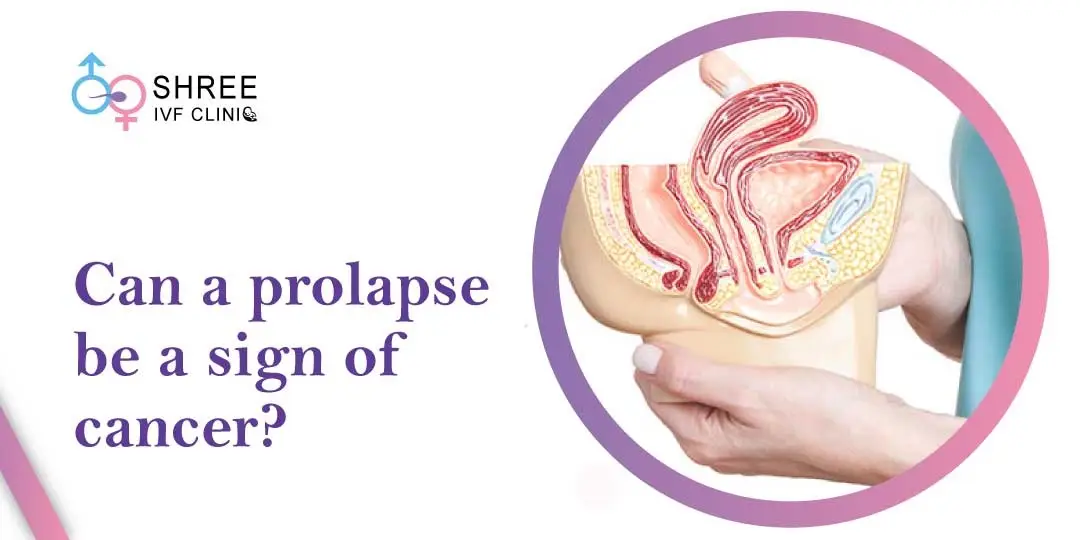Can pelvic organ prolapse be a sign of cancer? Exploring The Link Between POP & Cancer
UPDATED ON 11TH MAR. 2024
In the complex realm of women’s health, the term “pelvic organ prolapse” (POP) has gained more attention in recent years. But POP, a condition where pelvic organs descend from their normal position, isn’t just a matter of discomfort—it has implications that may reach far beyond what most women are aware of.
Could it be more than just a sign of age or a past pregnancy? Could it, in fact, be a latent herald of something graver—cancer?
In this article, we dare to venture into the often-overlooked possibility of a connection between POP and cancer. We aim to provide insights that not only raise awareness but also prompt readers to explore this topic further with their gynecologist.

AUTHOR
Dr Jay Mehta
Scientific Director & IVF Specialist with 10+ years of experience
CONDITION
GET IN TOUCH ON
Understanding the Pelvic Organ Prolapse at a Glance
First, before we delve into the potential cancer link, let’s lay the foundation with a clear understanding of what POP is. A complex web of muscles and connective tissues in the pelvic floor supports typically pelvic organs like the uterus, bladder, and rectum. When these structures weaken or are damaged, the pelvic organs can slip out of place, leading to POP. The condition is primarily prevalent among older women and those who have given birth multiple times.
The Common Causes and Risks of POP
POP can result from various factors such as childbirth trauma, hormonal changes during menopause, and the genetic predisposition to weak connective tissues. Other causes include obesity, chronic coughing, and heavy lifting. Specifically, the risk factors for POP include:
- Childbirth and Pregnancy: The act of giving birth can traumatize the pelvic floor, leading to weakness and later prolapse.
- Ageing: The hormonal changes and effects of gravity over time can weaken the pelvic floor support structures.
- Connective Tissue Disorders: Conditions like Ehlers-Danlos syndrome can contribute to the general weakness of connective tissues in the body.
- Obesity and Lifestyle: Excessive weight can place strain on the pelvic floor, increasing the risk of POP.
Recognizing the Symptoms of POP
The symptoms of POP can vary in severity but typically include:
- Sensations of pressure in the pelvic area.
- Feeling or seeing a bulge of tissue at the opening of the vagina.
- Urinary problems such as incontinence.
In severe cases, POP can lead to difficulties in bowel movements and sexual intercourse.
Parallel Pathways: Cancer and Its Indicators
As we pivot our focus to cancer, it’s essential to establish a foundational understanding of what we’re dealing with. Cancer represents a broad group of diseases characterized by the abnormal growth of cells beyond their usual boundaries that can invade adjacent parts of the body and spread to other organs.
The signs of cancer are numerous and can sometimes mimic other, less severe conditions, making diagnosis a complex process.
The Spectrum of Cancer Signs
The signs and symptoms of cancer can be diverse and are closely linked to the type and location of the cancer within the body. Common indicators include unexplained weight loss, changes in bowel or bladder habits, persistent pain, fatigue, and abnormal bleeding. These signals often prompt individuals to seek medical attention, leading to a cancer diagnosis.
Studies on POP and Cancer
While a direct causal relationship between POP and cancer isn’t universally acknowledged, there has been a growing body of research examining if one may be a risk factor for the other. A 2019 study published in the International Urogynecology Journal found that women with POP had a higher risk of developing certain types of cancer, including uterine and gallbladder cancers.
Exploring Research Findings and Their Implications
The implications of this and other similar studies are profound. By using large-scale databases, researchers have been able to draw significant correlations between the presence of POP and an increased likelihood of developing cancer.
While the exact mechanisms behind this association remain largely speculative, the data suggests that further exploration is warranted.
Research Limitations
It’s important to note that the existing research has limitations, including the challenge of accurately diagnosing POP and the potential for confounding variables. More robust studies with longitudinal designs and strict control over relevant factors are necessary to establish a clearer understanding of the relationship between POP and cancer.
Potential Underlying Mechanisms
Several potential mechanisms could explain how POP and cancer might be linked. Both conditions involve the growth and displacement of cells and tissues within the pelvic area, suggesting a shared underlying pathophysiology.
Cross-Examination of Biological Pathways
Hormonal imbalances, chronic inflammation, genetic factors, and immunologic pathways have all been implicated in the development of both POP and cancer. For example, estrogen levels influence the growth of tissues in the pelvic area and are also involved in the pathogenesis of certain cancers, such as breast and endometrial cancer.
The Intersection of Shared Risk Factors
Beyond the biological aspects, POP and cancer could share common risk factors such as obesity, smoking, and physical inactivity. These factors have been established as independent risk factors for various cancers. They can also contribute to the development of POP by increasing intra-abdominal pressure and straining the pelvic floor muscles.
Medical Opinions on the Controversy
While some medical experts are cautious about jumping to conclusions based on the current body of evidence, others are more vocal about the potential significance of these findings. The consensus seems to be that while the link cannot be ignored, it also cannot be overstated without further research.

4,790+
379K+
finding the right solutions tailored to their specific
circumstances can make all the difference “
The Gravity of the Situation: Why Seek Medical Attention?
Given the potential seriousness of the implications, it is crucial for anyone experiencing symptoms of POP or any unusual pelvic discomfort to seek medical evaluation. Early detection and intervention can improve outcomes for both POP and any underlying conditions such as cancer.
The Role of the Oncologist in a POP Diagnosis
Sometimes, the first specialist a woman may see for symptoms of POP is a gynaecologist or a urogynaecologist. However, if there is a suspicion of a more significant underlying issue, the path of care may lead to an oncologist, whose expertise can be vital in addressing any potential cancer diagnosis and treatment.
The Importance of Early Diagnosis and Intervention
For both cancer and POP, early intervention is critical. Treatment for cancer is most effective when the disease is caught in its early stages, and similar principles apply to POP. The earlier pelvic organ prolapse is diagnosed, the more treatment options can be considered. This underscores the importance of regular check-ups and being proactive about one’s health.
In Conclusion: A Call for Deeper Understanding and Vigilance
The correlation between POP and cancer is not to be taken lightly. While the current evidence does not provide a definitive link, it does warrant a closer examination by healthcare professionals and individuals alike.
The journey to unravelling the mystery behind this potential relationship is ongoing, and in the meantime, the message is clear: vigilance and early intervention are paramount. Women are advised to attend regular screenings, consult with their doctors if they notice any anatomical changes or discomfort, and maintain a lifestyle that reduces the risk of both POP and cancer.
Awareness is the first step towards prevention and effective management of these conditions. By taking an active role in understanding and heeding the signs our bodies are giving us, we pave the way for better health outcomes and a higher quality of life.
AUTHOR
Dr Jay Mehta
Scientific Director & IVF Specialist with 10+ years of experience
TREATMENT
CONDITION
CALL US 24/7 FOR ANY HELP
GET IN TOUCH ON
Share Article on
Related Readings
How is a Bleeding Prolapse Treated?
Epithelial, Germ Cell, and Stromal are ovarian cancer types which are classified by their originating cells
Can Pelvic Organ Prolapse Go Away On Its Own?
Uncover the potential for pelvic organ prolapse (POP) to resolve naturally. Explore symptoms, management options, and factors influencing resolution.
Why Does Uterine Prolapse Cause Bleeding?
Heavy periods, bleeding between periods, and postmenopausal bleeding are forms of abnormal vaginal bleeding that can severely impact a woman’s quality of life




